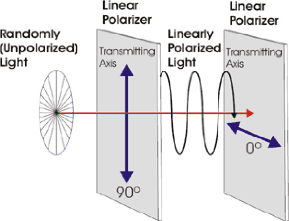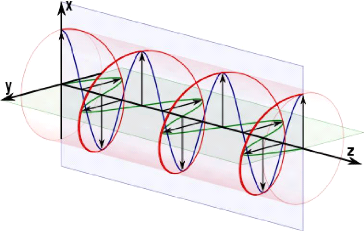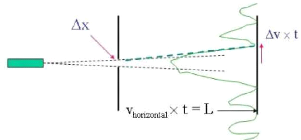2.1 Polarization
First, we will present the polarization of a classical
electromagnetic field and translate it in the frame of quantum mechanics.
According to Maxwell's equations in the vacum, we observed that light is a
transverse electromagnetic wave which means that the electromagnetic field is
perpendicular to the direction of propagation of the wave. To simplify, we will
consider a monocromatic wave which propagates along the z-axis :
E~ = ~Eocos(ùt - kz + ?),
(2.1.1)
Section 2.2. Circular polarization Page 9
Ex =
Eo v2coswt; (2.2.1)
2r
where w is a vibration frequency,
|Eo| is the amplitude, k is the wave vector given
by k = À , and À
is the wavelenght. The vibration frequency is given with the
relation
w = c x k, (2.1.2)
here c is the speed of light and ? is the phase at the
origine. The electomagnetic field is polarized in the plane perpendicular to
the direction of propagation thus we let z = 0.
2.1.1 Linear polarization. In the linear
polarization, the electric field describe a straight line in a single direction
which is the direction of propagation. The mathematical relation is given
by:
Ex = E0cosOcoswt, (2.1.3)
Ey = E0sinOcoswt. (2.1.4)
With Malus law, in the output of the polarization, the electric
field is proportionnal to the square of the intensity.
I' = Icos2(O -
á). (2.1.5)
If O = á - ð 2 that imply
in the output of the analyzer, we will not get any light.

Figure 2.1: Linear polarization
The orientation of a linearly polarized electromagnetic wave
is defined by the direction of the electric field vector
2.2 Circular polarization
The second polarization is circular, when the electric field
describes a circle in the plane during the propagation of the wave along
z. The wave is polarized circularly if
Section 2.3. Heisenberg Uncertainty principle Page 10
Eo
Ey =
Section 2.4. Entanglement Page 11
v2 sinùt. (2.2.2)
This is a general cas of polarization, where the polarization of
electromagnetic radiation such that the

Figure 2.2: Circular polarization
tip of the electric field vector describes an ellipse in any
fixed plane intersecting, and normal to the direction of propagation. The
mathematical definition is
ÇA cos ùt )
Ê= ;
B sin ùt
with A =6 B and A, B =6 0. satisfy
to
ÇX )2 ÇY )2
+ = 1. (2.2.3)
A B
2.3 Heisenberg Uncertainty principle
People are interrested in quantum mechanics such that they
made many research, experiences and found new concepts which clarify the theory
of quantum. In 1927, Werner Heisenberg discovered Heisenberg Uncertainty
Principle. Quantum system is a system which calls mesure, hermitian operators,
and observable, as define previously. Quantum mechanics is applied to the
microscopic domain of particle and its the principle for complementarity
[NAZ02] of two states, momentum and position. In general, Heisenberg
Uncertainty Principle is given by any hermitian operators denoted by x
and p, where x describes the position and p the
momentum of particle in certain coordonate. This principle simutaneously
increase the position and the momentum, it is impossible to measure a position
without disturbing momentum, and vice versa. This principle can be called a
principle of complementarity [NAZ02]; when the momentum is increased, the
position decreases and when the position increase the
momentun decreass (distribution is proportionnal). In general,
the Heisenberg Uncertainty Principle is given by the following formula:
~
ÄxÄpx = 2.
(2.3.1)
Note that Ä symbol is what we call Uncertainty.
The uncertainty principle is taken as a limitation of quantum preparation
(states)[BHL07]. There are many application on it such that in signal
processing with Fourrier transformation but the one domain that is interesting
to us is cryptography. We will see how this notion is applied in cryptography.
In this figure the uncertainty momentum is given by Äv is

Figure 2.3: Heisenberg Uncertainty Principle
still the same as Äp.
| 


